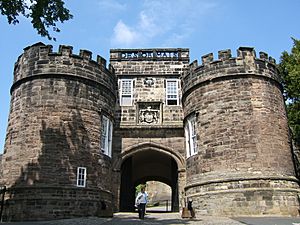Skipton Castle facts for kids
Quick facts for kids Skipton Castle |
|
|---|---|
| Skipton, North Yorkshire, England | |

Skipton Castle gatehouse
|
|
| Coordinates | 53°57′49″N 2°00′52″W / 53.9637342°N 2.0143676°W |
| Type | Castle |
| Site information | |
| Owner | The Fattorini family |
| Open to the public |
Yes |
| Condition | Complete |
| Site history | |
| Built | c. 1090 |
| Built by | Robert de Romille |
| In use | Until December 1645 |
| Materials | millstone grit |
Skipton Castle is a very old and important castle located in Skipton, North Yorkshire, England. It was first built around 1090 by a Norman baron named Robert de Romille. This amazing castle has stood strong for over 935 years, making it a truly historic place!
Contents
The Castle's Long History
Skipton Castle began as a simple "motte and bailey" castle in 1090. This meant it had a wooden tower on a raised earth mound (the motte) and a fenced courtyard (the bailey). It was built by Robert de Romille, who owned many lands nearby.
Later, around 1102, King Henry I gave Robert de Romille even more land. To make the castle stronger against attacks, especially from the Scots, it was rebuilt using stone. The castle was built on cliffs next to a stream called Eller Beck, which made it very hard for enemies to attack.
Changes and Battles
In 1310, the Romille family no longer owned the castle. King Edward II then gave it to Robert Clifford. He became the new Lord Clifford of Skipton. Lord Clifford started making many improvements to the castle's defences. However, he sadly died in a battle in 1314 before the work was finished.
Even with the work incomplete, Skipton Castle was strong enough to survive a raid by the Scots in 1322. The castle's new stone walls and improvements helped it stand firm.
The English Civil War
During the English Civil War (1642-1651), Skipton Castle was a very important place. It was the last stronghold in the north of England for the Royalists, who supported King Charles I. The castle was under attack for three years!
In December 1645, after a long siege, the Royalists finally agreed to surrender to Oliver Cromwell's forces. As part of the surrender, Cromwell ordered the castle's roofs to be removed. This was a common way to "slight" a castle, making it unusable for defence.
There's a cool legend that during the siege, sheep fleeces (wool) were hung over the castle walls. This was supposedly to soften the impact of cannonballs! You can even see sheep fleeces on Skipton town's coat of arms today.
Lady Anne Clifford's Legacy
Skipton Castle remained the main home for the Clifford family until 1676. Lady Anne Clifford (1590–1676) was the last Clifford to own the castle. After the Civil War, she took charge of repairing the castle. She even planted a special yew tree in the central courtyard to celebrate the castle being restored.
Lady Anne's daughter, Lady Margaret Sackville, married John Tufton, 2nd Earl of Thanet. The castle then passed down through the Tufton family. In 1871, it became the home of Lord Hothfield.
Today, Skipton Castle is a very well-preserved medieval castle. It is a popular place for tourists to visit and is also a private home. The castle is also the starting point for a long walking path called the Lady Anne's Way, which is about 100 miles long and goes to Penrith.
Modern Times
The Fattorini family bought Skipton Castle in 1956. More recently, the castle even got free Wi-Fi as part of a project to improve internet access in North Yorkshire.
Castle Design and Features
Skipton Castle has six strong, round towers, called "drum towers." A living area connects two of these towers on the north side, protected by the steep cliff overlooking Eller Beck.
Inside the Castle
On the first floor, you can find the original kitchen, the great hall (a large room for gatherings), smaller sitting rooms, and the lord's bedroom. The ground floor has new kitchens, storage areas, and work cellars. The other towers were mainly for military use.
In the 1500s and 1600s, some changes were made. A new entrance staircase was added, replacing the old drawbridge. A new living area was built, and larger windows were put into the original parts of the castle. The roof is still completely intact today.
In the very centre of the castle is a courtyard called the Conduit Court. Here, you can see the famous yew tree that Lady Anne Clifford supposedly planted in 1659.
Outside the Walls
The outer wall of the castle, called the "curtain wall," surrounds the inner parts and other buildings. This includes the remains of a chapel from the 1100s. Most of this wall is still standing. It has a Norman gatehouse with two towers.
The east tower of the gatehouse has a "shell grotto" from the 1600s. This is a special cave-like room decorated with shells. There are only two of these left from that time period, and the other is at Woburn Abbey.
There is also an ancient well at the castle. This well might explain how the people inside the castle survived the long siege from 1643 to 1645, as it would have provided them with water.
Images for kids
People Buried Here
Some members of the Clifford family are buried in the family vault at Skipton Castle:
See also
 In Spanish: Castillo de Skipton para niños
In Spanish: Castillo de Skipton para niños







